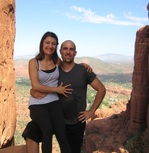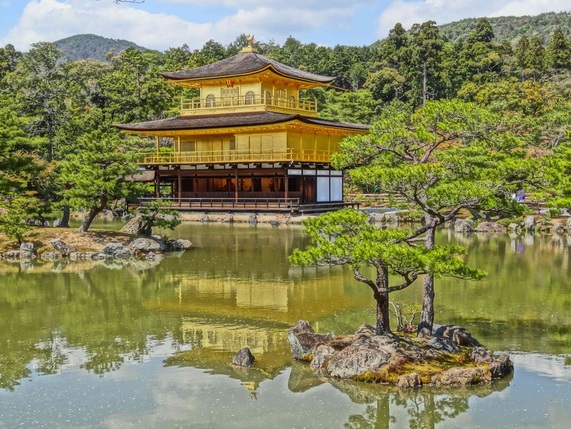 Kinkaku-ji - Temple of the Golden Pavilion Kyoto and its environs was our last major stop in Japan and many argue it is the most interesting area of the country. The seat of imperial power from 764 until 1869, it is one of the few cities in Japan spared from the ravaging air raids of WWII, leaving much of its historical legacy intact. During our time in the city, we visited an enormous amount of temples and palaces – a sort of sightseeing marathon that pushed us to our physical limits as we neared the end of a very long travel leg. In the end, however, we found that the lasting impressions were not of ornate palaces or the architecture of the temples, but rather of the tiny monochrome pebbles flowing through the gardens of the city.
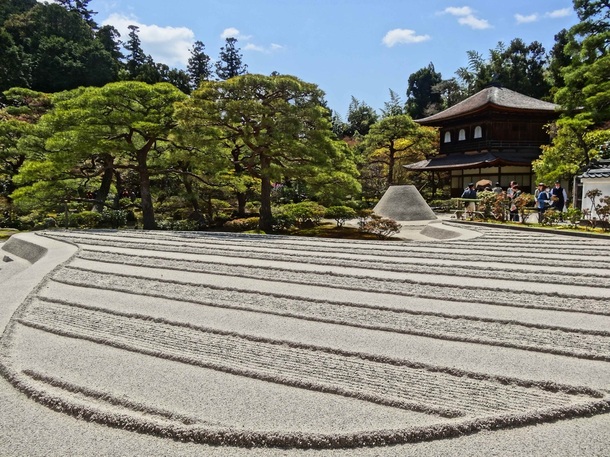 Ginsyaden Garden in Ginkakuji - the Temple of the Silver Pagoda 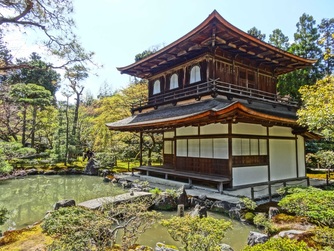 Our first Zen temple was Ginkakuji, sometimes called the Temple of the Silver Pagoda. Built in 1482 as a retirement villa for Ashikaga Yoshimasa, the aged, bared wood of the two story pagoda sits serenely overlooking a pond within an evergreen garden. Offset to the pavilion is the Ginsyaden garden, a bare rock landscape sculpted to resemble waves and the Kogetsudi, a white sand funnel shaped like Mt. Fuji. In this garden we see metaphor and reality playfully intertwined. The resemblance to an ocean and a mountain are unmistakable in the forms of the rocks, and yet are they not just rocks? The Zen garden invites us to see how we assign meaning to everything in our world while also prompting us to see the emptiness of that meaning. It is not a denial of meaning so much as recognition that sitting alongside our world of meaning is one much simpler and straightforward – the world simply as it is. Despite its apparent clarity, it can actually be quite difficult to see this world as it is – we so easily fall back into only our world of constructed meaning.
A visit to Kiyomizu Temple challenged how dedicated we must be in order to see this world as it is. The temple is built on a steep cliff in eastern Kyoto with its main porch and altar facing directly off a 50 foot drop onto the ground below. It calls to mind a famous Zen Koan, by Mumon: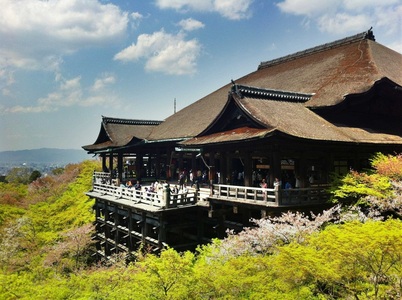
“There is a man on top of a hundred-foot pole. Though he has a degree of understanding, he's not yet a man of the Way. From the top of the hundred-foot pole he should advance a step further and the ten directions of the world will be his entire body."
In this koan, a man climbs to the top of a 100 foot pole and is told by his teacher that to advance to enlightenment, he must just climb a step further up the pole, which of course doesn’t exist. Or does it? The implication is that to see the world as it is, we must be willing to cast off our closely held ideas of reality and take the plunge into the unknown, leaving body and mind on the pole, as it were. In the case of Kiyomizu, this may have been taken a bit too literally. It was believed that jumping off the porch would grant the jumper a wish. During the Edo period, 234 jumps were recorded, but only 85.4% survived. Ouch.
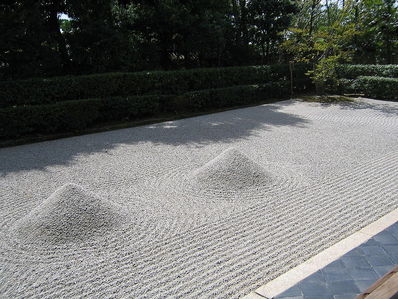 Next we visited Daisen-In Temple, which is within the Daitoku-ji Temple complex in northern Kyoto. The Muromachi period garden is famous for its metaphorical representation of the human lifecycle, starting from the vividly three-dimensional Mt. Horai (land of the immortals in Daoism) and moving past various symbolic naturalistic representations of the lessons we must learn to move towards enlightenment. A turtle-shaped rock, for example, appears to flow against the stream of the river, symbolizing the futility of fighting time, while a treasure boat shaped rock floats serenely with the river towards the Great Ocean. It is this ocean that was most captivating to me, a long stretch of carefully raked pebbles broken by only 3 objects. Closest to the viewer are two conical piles of stones rising out of the sea. They represent our brief moment of individuation from the Great Ocean. Beyond them, in the far corner sits a small bodhi tree. The message was vivid to me - we must return to the ocean, allow ourselves to dissolve back into the Great Sea, to find the other shore of enlightenment. Perhaps Zen master Tessho said it best in his death poem:
Finally out of reach -
No bondage, no dependency.
How calm the ocean,
Towering the void. 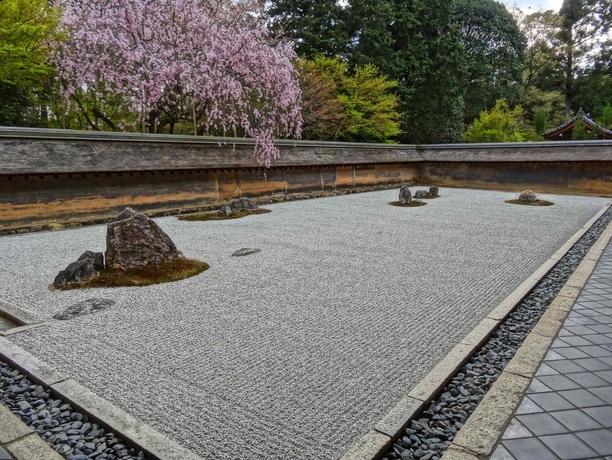 Ryoanji Zen Garden Our last rock garden was perhaps the most famous, the 15 stones of Ryoanji. Here we come full circle, for the rocks at Ryoan-ji are said to represent nothing at all in the natural or mythical world. Here a rock is just a rock. The composition of the stones was designed to absorb the viewer, making him/her more conducive to the meditative state. We leave the realm of metahpor that our ego-minds dwell in 24/7 and come fully to this moment. In the end, no level of thought can help us to arrive there. But the message of Ryoan-ji is that inspiration towards “suchness” is to be found in all the myriad forms that surround us in day to day life. If there is “good news” in Buddhism, it is this. The world is full of suffering, yes – but it also offers infinite pathways to freedom and the relief of that suffering.
In the end the paradox of the Zen Garden is that they represent BOTH nothing AND something. It is to live simultaneously BOTH in this world of meaning AND in the world of suchness. Some early historians mistook Zen for a nihilistic tradition, but the truth is that Zen is not a tradition of neither/nor, but rather one of both/and.
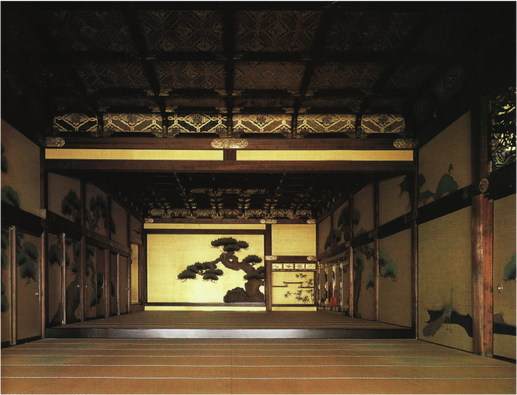 Kano naturalistic paintings on the walls of Nijo Palace. It is here that the Shogun met with his daimyo. Beyond the inspiration of the gardens our time in Kyoto was full of historical sites as well. We enjoyed the architectural paranoia built into Nijo castle with its “nightingale floors,” which are designed to squeak like the little birds with even the slightest footfall. Built by the great shogun Tokugawa Ieyasu, founder of the long-lasting Tokugawa Shogunate, the palace shows the fear that even great leaders lived under in feudal era Japan. But it also demonstrates the beauty they lived with, as represented by the captivating naturalistic paintings of the Kano painters and the intricate gardens on the grounds. 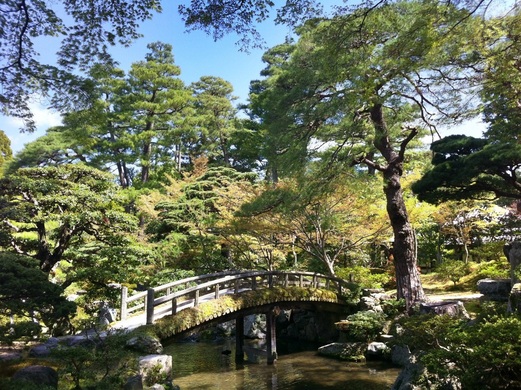 The Emperor's Private Garden at the Kyoto Imperial Palace Being home to the Emperor for so long, Kyoto’s Imperial Palace was also fun to stroll around, particularly to see the beauty of the Gonaitei, the Emperor’s private garden and the Oikeniwa, a stroll garden that offers different perspectives as you walk. The buildings themselves were largely reconstructed after fire in 1855, but were still interesting because of the relationship between the Emperor and Shogun during this time. The Emperor was effectively held hostage to the shogun’s demands over a 500 year period, sometimes even having to sign an “Imperial Decree” just to feed the royal family. 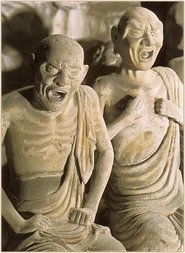 From Kyoto we spent a few days in Nara, the first capital of Imperial Japan from 710-784. The most notable sight lies outside the city in the form of the first Buddhist Temple ever built in Japan – Horyuji. Its builder, Prince Shōtoku, is still venerated in Japan as the progenitor of Japanese Buddhism. It contains the world’s oldest surviving wooden structures, dating from 711. Our tour with a local guide who was practicing his English gave us innumerable insights into the majestic old pagoda, which features various Buddhist scenes at its base. The most striking scene is that of the death of the Buddha, where his disciples are depicted as agony stricken over the loss of their teacher.
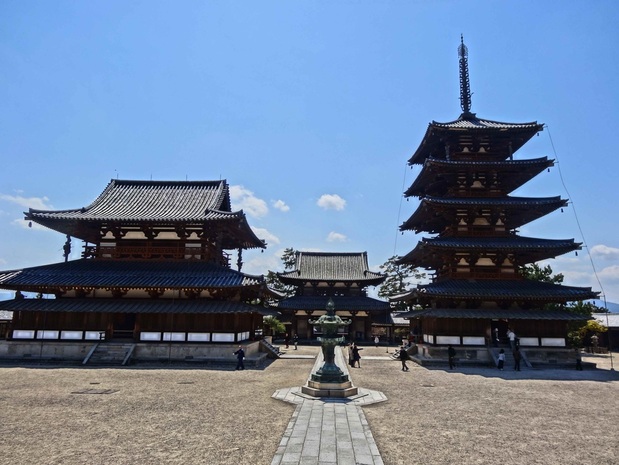 The oldest wooden buildings in the world at the Horyuji Temple outside of Nara 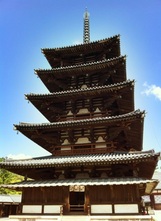
Japan experiences over 1000 earthquakes a year, a fact brought home to us as we awoke at 5:30 in the morning to our swaying hotel as a 6.3 magnitude shake reverberated out from Osaka. Pretty scary when you’re on the 12th (and top) floor of a hotel! Amazingly, the Pagoda’s engineering has made it impervious to such quakes over the centuries, leading its engineering principles to be studied and replicated in modern-day buildings.
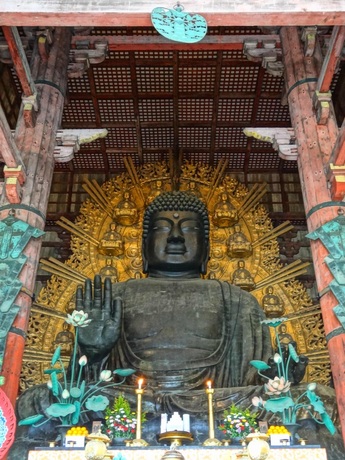 The massive Daibutsu statue The other highlight of Nara is Todai-ji temple, which contains the Great Buddha Hall, or Daibutsuden. It was reconstructed in 1709 and its predecessor was said to be 30% larger still than the current building, which already ranks as the largest wooden structure in the world! But the real highlight is what the Great Buddha Hall houses...a Great Buddha of course! Towering 52 feet high, the Daibutsu is made up of 437 tons of bronze, 286 pounds of pure gold, and 7 tons of vegetable wax. It was commissioned by Emperor Shomu, who believed that if all the people of Japan joined together to make this Buddha image, it would encourage the Buddha to protect their kingdom. As a result, more than 2.6 million people worked on the construction of the Buddha and the hall over the years it took to build the structure and the eight castings required to get the bronze to take shape. In the end it nearly bankrupted the kingdom, so maybe the Buddha was sending a message that he doesn’t care too much about giant images, particularly since he explicitly said not to worship him after his death...tsk, tsk Emperor Shomu!
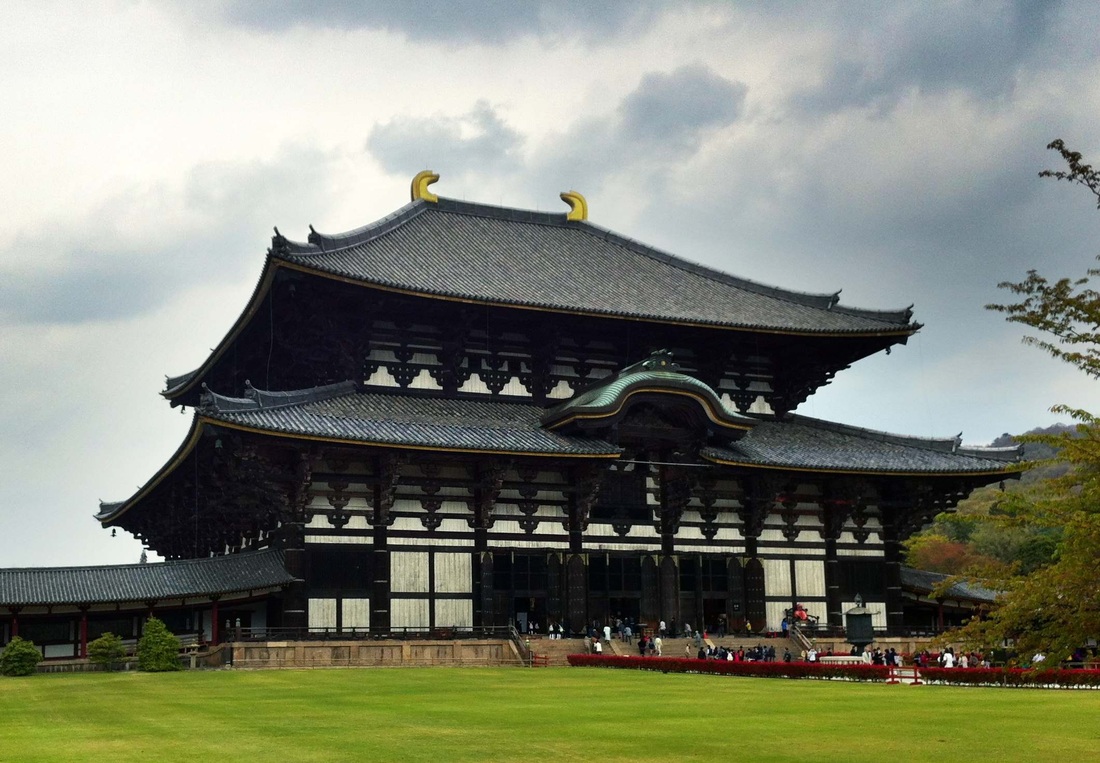 The Great Buddha Hall, or Daibutsuden in Todai-ji is the largest wooden structure in the world and holds the worlds largest bronze Buddha image (above) 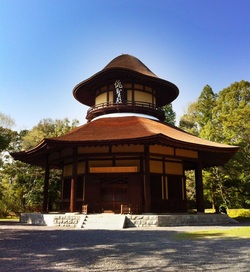 Haiseiden - Basho Memorial Our last real tourist stop in Japan was the birthplace of Matsuo Basho, the famous Zen poet who we featured in our Tokyo post. The town features several museums on Basho as well as his childhood home, but unfortunately all of them are in Japanese. Fortunately, there was another tourist attraction nearby that didn’t require much English because Iga-Ueno is also famed as the birthplace of Ninjitsu! During the month of April the city hosts a Ninja festival where everyone in the town is invited to dress up as a ninja (for a $10 fee) and test themselves with various feats of agility and dexterity. While we had had enough dress up for one trip with our samurai and kimono stint, we had a great time watching the kids and marveling at the little ninjas the town had discretely placed all along the street.
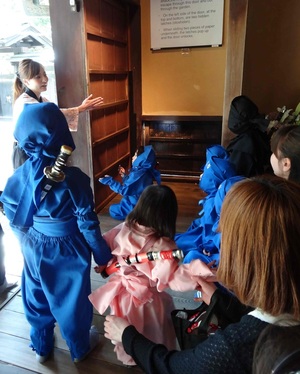 Ninja house tour with little ninjas We also enjoyed the Iga Ninja museum, where we learned about the way Iga-Ryu Ninjas trained and practiced. Apparently, it was common for them to disguise themselves as farmers until called upon by a liege lord to commit an act of espionage - be it reconnaissance, diversionary tactics, or assassination. As such, they would combine typical farmer’s scythes to make grappling hooks and had interesting ways of hiding their weapons. This was really emphasized in the tour of a typical ninja house, which is full of hidden doors and escape passageways that aim to provide the ninja a fast exist but also to hide his secret technique for producing gunpowder (a powerful military secret at the time). Of course, no ninja museum is complete without a live show performance featuring shuriken throwing and mock fighting.
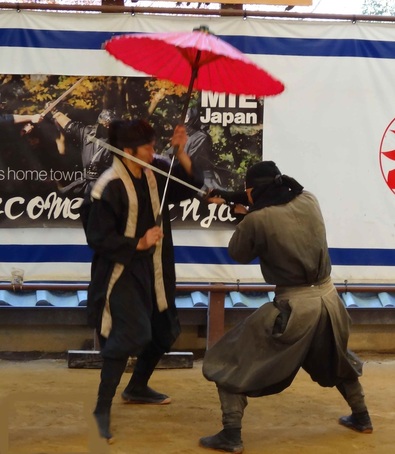 Mock ninja fight showing how an umbrella could conceal a sword! Segoi! (Japanese for amazing) The ninja festival was too cute to not include a few extra pics. Here are some of our favorites: 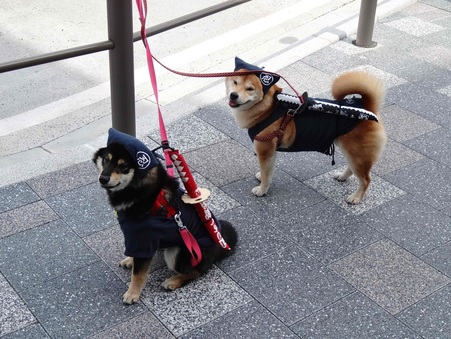 Japanese folks had some pretty intricate costumes for their dogs, but I think this took the cake for cutest 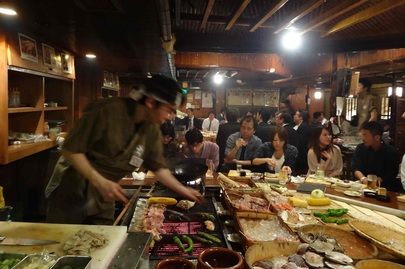 Izakaya in action Finally, it was time to turn the page on our Japanese adventure. We headed to the city of Osaka excited due to its reputation as the food capital of Japan. It didn’t disappoint as we ate our fill of sushi-train (invented in Osaka along with the instant noodle in 1958), okonomiyaki (also invented there), and izakaya foods. The izakaya we enjoyed with a couchsurfer named Nathan who was living in Osaka and agreed to meet up with us to show us around town a bit. Izakaya is basically live action grilling combined with the consumption of large amounts of beer. What’s not to like? After dinner, Nathan showed us a cool little brew bar that served up delicious cask-pulled IPA’s and stouts. Thanks buddy! We also enjoyed the parks around Osaka Castle and particularly the Japanese mint as it contained a variety of late blooming double-pedaled cherry blossoms that gave us yet another glimpse of these wonderful trees so important to the Japanese national psyche.
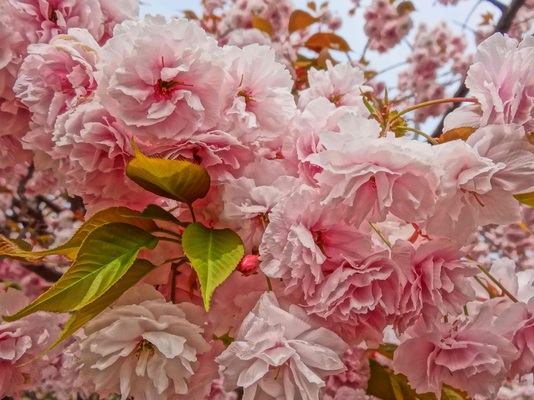 The "Torinuke", or Cherry Blossom Tunnel outside the Osaka Mint is renowned for its late blooming double petal varieties of the cherry blossom Our time in Japan was full of rich experiences – from the reminders of our cherry blossom nature to connections beyond words with our Japanese family in Shiojiri. From the historical pensiveness engendered by Hiroshima to the contemplation stimulated by the gardens of Kyoto. We feel nostalgic about our time here but are also excited as we head to Japan’s neighbor, South Korea, for a 6 day stopover for some Seoul food! See you there!
In Buddhism, there is a worldview which posits 6 realms of existence through which human beings move during their cycles of reincarnation. In American Zen thought, these realms are not considered to be real places, but allegories of how we keep ourselves in “dukka”, or suffering. I remember a wonderful talk by AZC senior lay-practioner Pat Yingst on these realms of existence where she suggested that in any given day we could move through all 6 realms as we found various ways to divide ourselves from the present moment – to keep ourselves alienated from the world around us. 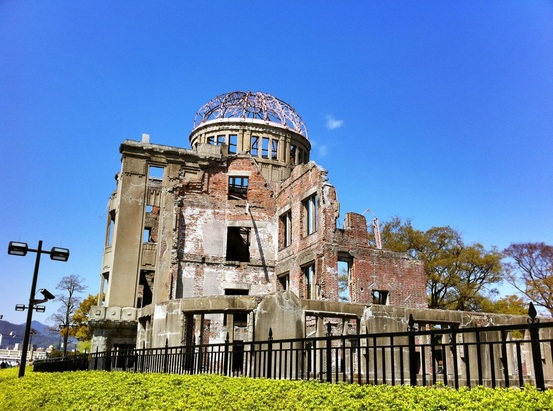 The "A-Bomb Dome", formerly the Hiroshima Prefectural Commercial Exhibition Hall was one of the few buildings close to the blast radius to survive As we visited Peace Park in Hiroshima, the site of the dropping of the first atomic bomb on August 6th, 1945, I felt like I was moving through all 6 hell realms as I tried to understand the the reasons for it being dropped and the devastation that ensued. At first I felt it was entirely unnecessary to drop the bomb and at other times I wasn't so sure. The fact is, it was a messy situation with many different factors involved. In order to capture this experience, we will look at each realm and how it may connect within a historical context to the first half of 1945, when Japan was losing the war but unable to come to a peace agreement with the allies.
1. The Realm of Devas (Gods) and Heavenly Beings
The Deva realm is populated by godlike beings who enjoy great power, wealth and long life. They live in splendor and happiness. Yet even the Deva grow old and die. Further, their privilege and exalted status blind them to the suffering of others, so in spite of their long lives they have neither wisdom nor compassion.” The fanaticism of powerful aspects of the Japanese military government seemed to be residing in this realm, where they were completely disconnected from the suffering of their people. Even as Japan’s navy lay destroyed and surrender seemed inevitable, the Big Six or Supreme War Council in Japan, declared a formal policy of the "honorable death of the hundred million" - national suicide. 2. Asura-gati, the Realm of Asura (Titans) The asura realm is populated by powerful beings who experience a life that could be almost as pleasurable as that of the devas in the heaven realm. However, the asuras are very envious and suspicious of each other and the devas, so they spend their time absorbed in great wars and conflicts instead of enjoying themselves. The realm is full of assembling armies and asuras in battle gear. Even though they value justice, wisdom and faith, they always desire to be superior to others, so they are competitive and egotistical. Sounds a bit like the cold war, huh? The Hiroshima Peace Memorial Museum outlines how during the February 1945 Yalta Conference including Roosevelt from the US, Churchill from the UK, and Stalin from the USSR, the USSR agreed to enter the war against Japan three months after a German surrender. The US and UK made concessions to achieve this agreement, like granting the USSR railways in Manchuria and Port Arthur. But once the atomic bomb was successfully tested in the Trinity test of July 16th, the US began to fear that the Soviet Union entering the war and providing the decisive step in the surrender of Japan might lead to their expansion of influence throughout the Pacific. They wanted to limit Soviet control and a belief was that dropping the bomb might cause Japanese surrender prior to the Soviet Union entering the war. So with their mistrustful power struggle as a motive, over 100,000 people died unthinkable deaths as the heat, radiation, and shockwaves poured over an entire city. 3. The Human Realm
The Human Realm is the only realm of the six from which beings may escape samsara. Enlightenment is at hand in the Human Realm, yet only a few open their eyes and see it. Rebirth into the Human Realm is conditioned by passion, doubt and desire. It’s ironic that the military commanders of Japan claimed they would not surrender unless the Emperor system was retained in Japan. Some argue that by the Emperor system, they simply meant the old militaristic order in Japan, which they controlled. The Japanese Ambassador to Russia, Naotoke Sato, wrote to the Big Six prior to the bombing that an unconditional surrender with the sole proviso of the preservation of the Emperor would probably even be accepted, but the Japanese leadership refused to consider it. Why? The military were all to human in holding onto their positions of power at the cost of their own people, even when given the choice to have the Emperor remain in some position of authority (which he did after the war). 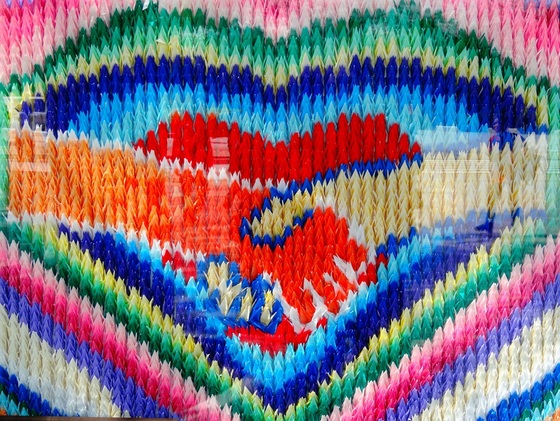 Paper cranes at the Children's Peace Monument honor Sadako Sasaki, who was exposed to the bomb at the age of 2 and seemed healthy until developing Leukemia 10 years later. She attempted to fold a 1000 cranes in the hope it would help her recover. per old Japanese folklore. Sadly, she only reached 644 before dying on October 25, 1955. Her friends and family finished the cranes for her and now children all over Japan fold in her memory. 4. The Animal Realm
Animal beings are marked by stupidity, prejudice and complacency. They live sheltered lives, avoiding discomfort or anything unfamiliar. Rebirth in the Animal Realm is conditioned by ignorance. People who are ignorant and content to remain so are likely headed for the Animal Realm, assuming they aren't there already.
Even after both bombs had been dropped and the Soviet Union entered the war against Japan, the Army (led by minister Anami, who committed suicide after the war) was unwilling to surrender, wanting to make terms that were more favorable to Japan. There was even a coup, called the Kyūjō Incident, where hardline factions within the military attempted to assassinate key parties to prevent surrender. With this sort of fanaticism, even in the face of clear defeat, was there any choice about whether to drop the bomb? The Army held a crucial seat on the Big Six and could effectively block any entreaties for peace, which they did even after both bombs were dropped. Only the Emperors intervention ordering them to make peace eventually forced Japan to surrender.
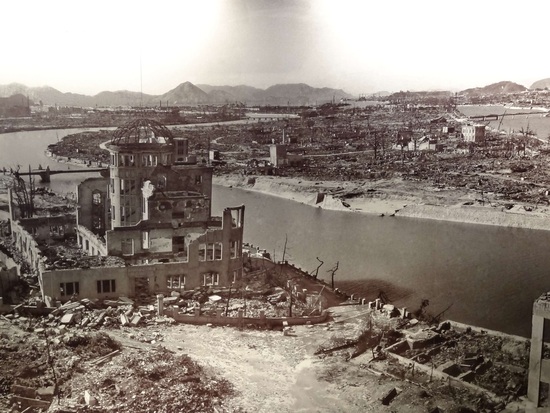 Epicenter of blast area - Hiroshima. The A-bomb dome sits shattered in the foreground. 5. The Realm of Hungry Ghosts
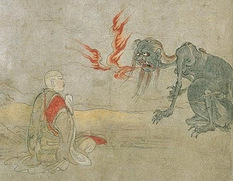 Hungry ghosts (preta) are pictured as beings with huge, empty stomachs, but they have pinhole mouths, and their necks are so thin they cannot swallow. A hungry ghost is one who is always looking outside himself for the new thing that will satisfy the craving within. Hungry ghosts are characterized by insatiable hunger and craving. They are also associated with addiction, obsession and compulsion.
The Manhattan Project was achieved at a cost of over 2 billion dollars and the work of over 120,000 people. It was a massive expenditure of resources and those behind it, like Director of War Mobilization James Brynes, worried that if the bomb wasn’t used and proved effective, criticism and investigation would follow. The Secretary of War, Stimson, supposedly said to President Truman that he worried that the already bombed out Japanese cityscapes would prevent the US military from measuring the true effectiveness of the weapon. Thus, potential target cities were not subject to air-raids in the months before the bombing.
6. The Hell Realm
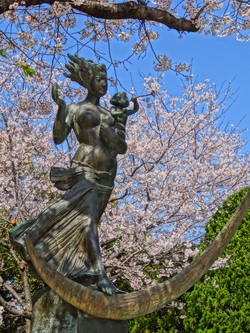 As the name suggests, the Hell Realm is the most terrible of the Six Realms. Hell beings have a short fuse; everything makes them angry. And the only way hell beings deal with things that make them angry is through aggression -- attack, attack, attack! They drive away anyone who shows them love and kindness and seek out the company of other hell beings. Unchecked anger and aggression can cause rebirth in the Hell Realm. Despite having no bargaining chips, the Japanese military developed the Ketsu-go strategy, which was to have such a fierce defense of the Kyushu beaches that Americans would take incredibly heavy casualties on their first assaults of the Japanese mainland. They hoped the Americans would blanch at such losses and negotiate peace in a way that would grant the military continued power over Japanese society. Still, there is belief among some historians that even without the use of the atomic bomb, which killed between 90,000–166,000 people in Hiroshima (of acute symptoms alone) Japan would have surrendered. This assumes a continuation of the conventional air raids that had already pulverized most of Japan’s cities. We have seen the results of this as we travel around the country to find most of the gardens and castles to be reproductions built since the war. Amazingly, by March of 1945 “conventional” warfare was nearly the equivalent of the atomic bomb in destructive capacity. Waves of small napalm like bombs were dropped onto the city’s civilian population and the fires spread and connected into a huge firestorm that sucked all the air out of the atmosphere. In one such raid in Tokyo, 125,000 people perished. The Allies bombed Hamburg and Dresden in the same manner, and Nagoya, Osaka, Kobe, before then bombing Tokyo a second time.
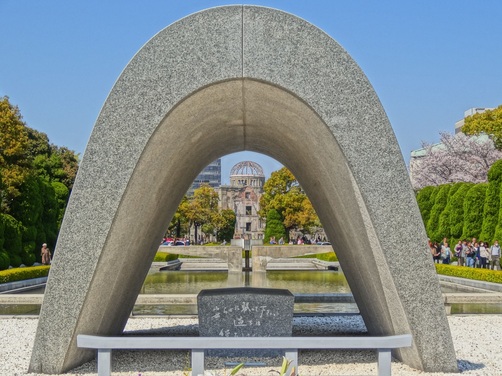 Flame of Peace & A-bomb Dome as seen through Hiroshima Peace Memorial Well, we’ve moved through the six realms of human existence and examined the different aspects of the decision to drop the bomb on Hiroshima. For me it was an incredibly emotional experience to read about the abstract decision making on the part of both sides but to then so viscerally see the effects of those decisions on the innocent civilians of Hiroshima. So often it is the least of us who suffer for the ignorance and delusion of the powerful. We've shared many of the pictures of the Hiroshima Peace Park & Museum above, but to see all the pics of the area as well of Miyajima (mentioned below), click here: 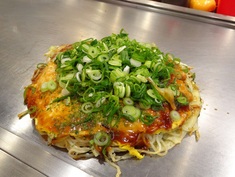 Feeling a bit somber after the museum and exploration of Peace Park (which you’ve seen in pictures above), we headed off to the famous institution of Okonomiyaki-Muri, where there are 3 floors of cooks all dishing up the Hiroshima version of the Japanese pizza/omelet. All the cooks entreated us as we looked at the different stalls, which featured Okonmiyaki made up of layers of ingredients instead of mixed together.
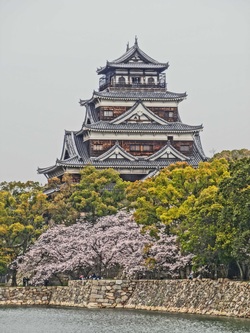 The next day we paid a visit to the rebuilt Hiroshima Castle, where we learned about the different construction styles of castles throughout Japan. This ranges from mountaintop castles built for defense in the early days of the Shogun to later peace-time castles built on flatlands that served mainly administrative functions. Then we took the ferry over to the famous Miyajima Island, right off the coast of Hiroshima in the Seto Inland Sea. The island is famous for the Itsukushima Shrine, a Shinto shrine with a beautiful Torii gate that appears to float in the water at high tide. We also enjoyed the Shingon Buddhist Temple of Daishoin, which features a cave symbolizing the entire 88 temple pilgrimage route of Shikoku and humorous Buddhist related statuary like the five hundred Rakan (many of which sported adorable quilted hats). The colorful temple also sported a long nosed Tengu (mountain spirit and defender of the dharma) and fierce looking Myo-o Buddhas who are committed to “encouraging” humans to follow Buddhism. Glad I didn’t meet one of them when I first started meditating!
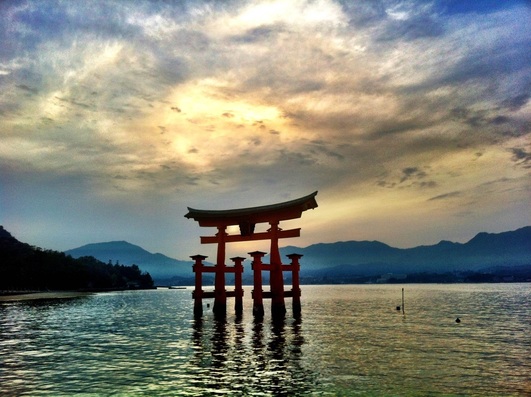 Itsukushima Shrine off Miyajima Island 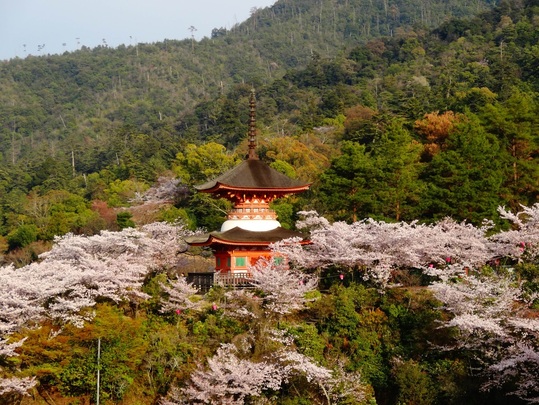 Tahoto Pagoda in Miyajima with an honor guard of cherry blossoms 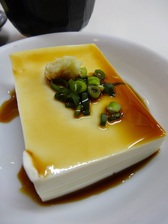 Mmm...tofu From Hiroshima we took another trip on the Shikansen to arrive in Okayama, famed for its Korakuen Garden. Hungry for lunch, our first stop was at Okabe Restaurant, which specializes in home-made tofu. Oishi! (Japanese for delicious). Then onto the park, which was full of cherry blossoms in full bloom. One of the most interesting features of the garden is its use of " borrowed scenery", incorporating the nearby Okayama Castle into the various views you experience as you stroll along its paths. But the highlight may have been after the garden, as we walked along the Asahigawa Sakuramichi Walk, lined with over 250 Someiyoshino cherry trees in full bloom. The trees were lined with revelers having hanami parties (cherry blossom viewing parties) so we figured, “when in Rome!”. We bought ourselves some snacks and beers and sat down under the trees to enjoy them Japanese style!
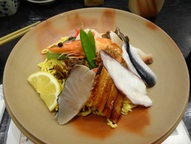 The next day brought rain and a day to relax (and for me to write this blog). We also had an excellent lunch sampling the local specialty of barazushi and a wonderful dinner with duck cooked on a charcoal grill and cold soba salad. Perhaps most charming in this small town was how the servers at both places we ate dinner walked outside to say goodbye to us, making us feel like family.
Despite the sordid history discussed in this post, traveling through Japan today certainly seems more like traveling through the Deva realm rather than the hell realm it had become by the end of World War II. But maybe by remembering how easily we can move from one realm to the other, in our individual lives and in our national policy, can help avoid such wanton destruction in our future. For all the pictures of Okayama & the Korakuen Garden click here:
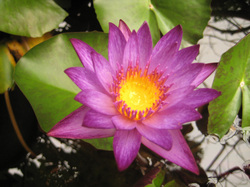 "Toward the end of his life, the Buddha took his disciples to a quiet pond for instruction. As they had done so many times before, the Buddha’s followers sat in a small circle around him, and waited for the teaching. But this time the Buddha had no words. He reached into the muck and pulled up a lotus flower. And he held it silently before them, its roots dripping mud and water. The disciples were greatly confused. Buddha quietly displayed the lotus to each of them. In turn, the disciples did their best to expound upon the meaning of the flower: what it symbolized, and how it fit into the body of Buddha’s teaching. When at last the Buddha came to his follower Mahakasyapa, the disciple suddenly understood. He smiled and began to laugh. Buddha handed the lotus to Mahakasyapa and began to speak. “I have experienced the true Dharma eye, the marvelous mind of Nirvana, the true form of the formless, the subtle Dharma Gate that does not rest on words or letters but is a special transmission outside of the scriptures. This I entrust to Mahākāśyapa.” ( www.katinkahesselink.net)
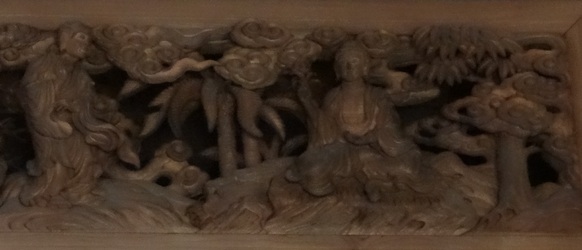 The story of the flower sermon, Buddha's transmission of the truth beyond words and letters, above the main altar of the Butsuden in Eiheiji monastery 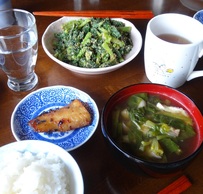 Miso soup was waiting for us! From Tokyo, Neda & I were excited to head up to the mountains of the Nagano prefecture, in the small town of Shiojiri, to visit our friends from Bodhgaya, India who had invited us to their hometown. When Rika first heard we actually were going to visit her up in the mountains, she was surprised and ecstatic. After all, she had invited other “gaijin” (foreigners) on her travels, but none had actually come to visit. She wrote excitedly, “Miso soup will be waiting for you!” and we knew that we were in for a warm welcome and looked forward to seeing Japanese culture from a more intimate perspective.
The first place we stopped was at Kouryu-ji Temple, the home of Toha-Osho and his family. Toha was one of two Zen Priests we met at Nippon-ji and he had taken care of us while we were in India. While we caught up over tea, we told Toha we would try to visit Eiheiji Temple after our visit with them, but only for the day because it seemed impossible to arrange for a longer visit when we called with Rika from India because we didn’t speak Japanese. It is a training monastery and they can only handle English speakers on specific dates when they have prepared for it. Eiheiji is an important place of pilgrimage for Neda and me because it is the home monastery of the Soto Zen Sect, which we practiced at the Austin Zen Center. We also talked to him about recommendations on where to buy some calligraphy, which we wanted as a souvenir from Japan. He told us, “Calligraphy very expensive to buy. I will make some for you.”
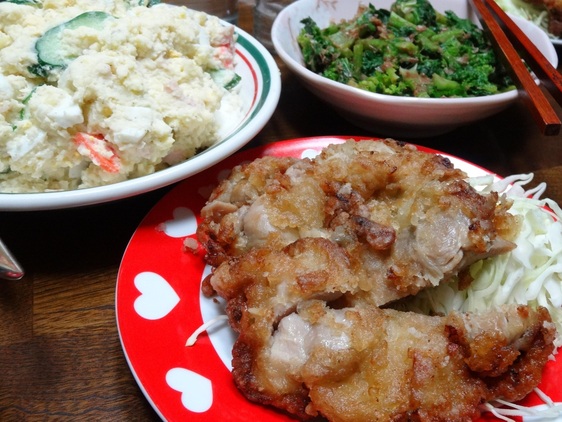 Delicious Sanzoku-Yaki, (山賊焼き) (deep fried teriyaki chicken thigh) with homemade greens It was this kind of utter generosity that made us feel like we were at a home far away from home. Arriving at Rika’s house her mother had brought us some of the local specialty, Sanzoku-Yaki, (山賊焼き) (deep fried teriyaki chicken thigh) and prepared fresh miso soup and greens. We waited until the evening for our friend Riko (also from Bodhgaya in India), who came up to join us from Chiba, near Tokyo. 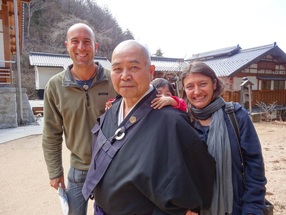 Rev. Ogasawara and his granddaughter Then it was off to a busy day as we headed to Kotaku-ji Temple to visit with Rev. Ogasawara (the senior priest from Bodhgaya, who had led the sesshin there). We enjoyed tea with him and discussed Zen before everyone got to try their hand ringing the temple bell! Then we headed off to Matsumoto Castle, which features the oldest five-tiered keep in all of Japan. The sun gleamed off of the “black crow”, named after the dark hues of the stained wood of the castle. Hitoshi-san (Rika’s Dad) told us about an interesting feature of the castle, which is that it actually has 6 floors (instead of the 5 you see from the outside), one of which is a hidden floor where gunpowder and other valuables were stored.
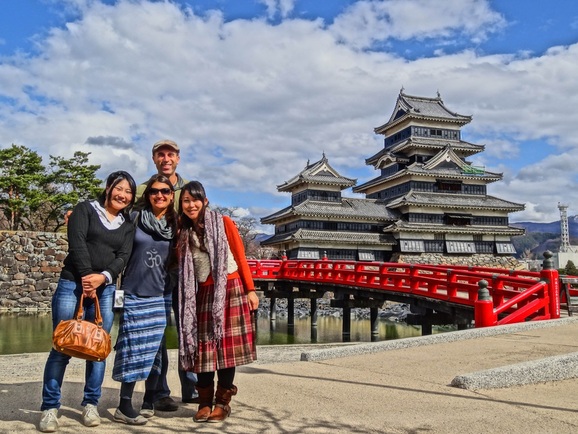 From left, Rika, Neda, Jeff & Riko enjoying a day at Matsumoto Castle On our return back to Shiojiri, we visited Toha-osho’s temple again, where he told us that he had spoken to the folks at Eiheji and they did have a foreign group visiting on April 1st and we could join them, if Toha-osho came along. So he told us he would drive us out to the temple (5 hours!), stay with us overnight and then head back. Sugoi! (Amazing in Japanese). Rika agreed to join us and we had our road trip/pilgrimage set!
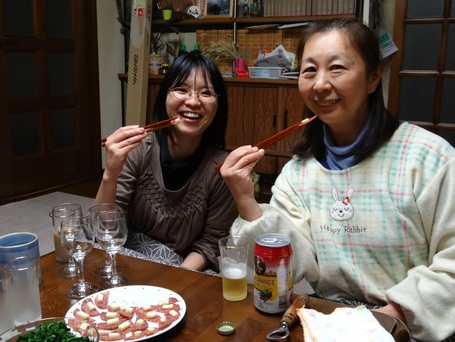 Chizuko-san and Humina-San try Bulgarian appetizers Japanese style (with chopsticks!) 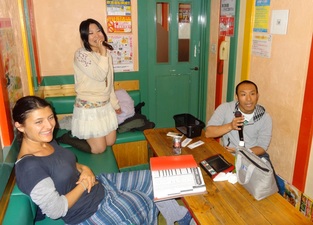 The next few days passed like a spring breeze as Rika’s brother Shu-san, sister-in-law Humi-san and little niece Yuki came to visit for the weekend. We had an amazing time as we cooked them a Bulgarian meal (served Japanese style) and went out with Shu & Rika for a night of fun Karaoke (which for those who might not know, originated in Japan). The next day was all preparation as the family readied the “irori” for a grand feast that night. Their irori was built by Hitoshi-san and his father in a small separate house off the main house. It consists of tatami mats surrounding a special pit filled with sandy earth. Over the pit goes the grill, and when the fire is ready all sorts of delicious meats and veggies are lovingly cooked. We sampled tender grilled scallops still in the shell and finished off with some butter, marinated beef, Japanese mushrooms, succulent chicken legs, shrimp, and hand caught little sweet-fish that you eat whole. Toha-osho joined us for the gathering and on his way in, nonchalantly handed us some beautiful calligraphy he had made for us, despite being terribly busy with a funeral service over the past couple days. The night finished with the family sharing some special Cherry-blossom infused sake with us to try – the delicate blooms still floating in the fragrant liquid.
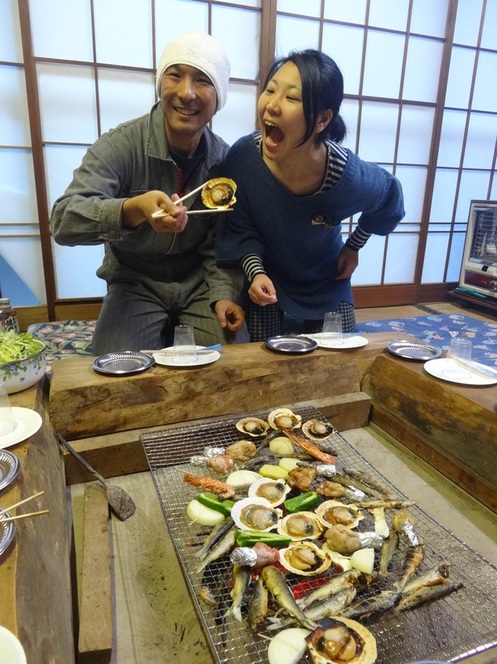 Rika enjoys a scallop from brother Shusuke-san during our irori feast! On Sunday, our last day together with the whole family, we took everyone out for Kaiten-zushi (sushi-train), which is adorable in Japan. Not only is there the normal sushi moving around the conveyor belts, but when you make custom orders it comes to you on a mini-bullet train (Nozomi Shinkansen) that stops at your table before zooming off to the next stop. Sugoi! 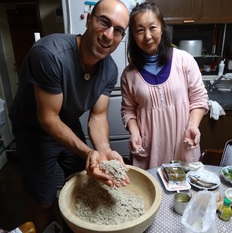 The evening was another highlight as Chizuko-san, Rika’s mother, took us into the kitchen and taught us how to make home-made soba noodles. We learned to serve them warm where they are dipped into a vegetable laden soup with a bamboo strainer. But the local specialty is to serve them cold on a bamboo basket (zaru-soba) where you eat the noodles by dipping them into a light soy broth and then quickly slurp them into your gullet! Hitoshi-san showed us how it was done brilliantly the first time, but I wanted to capture it on video. Sufficed to say, the 2nd attempt wasn’t as cleanly executed, but it made for this hilarious video!
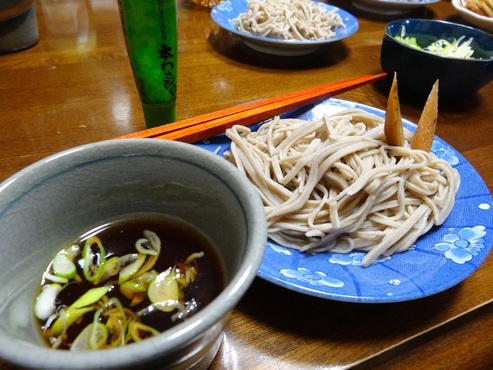 Our homemade zaru-soba! Note that the thicker noodles were the attempts by Neda & me! You might be wondering by now why this post opened with the story of Mahakasyapa. In the story, Mahakasyapa is the only disciple to understand that connecting deeply to the reality of all things is not dependent on words, but comes only from direct experience. A corollary of this lesson could be that our connection as human beings is also not dependent upon words. There has been no time where we felt this more deeply than at Rika’s house, where other than Rika, no one else in the family spoke more than a few words of English! Here we were bonding with the family, cooking together, playing with the little Yuki-monster and yet not actually communicating in words. We truly felt like a part of the family and yet we hadn’t actually ever “spoken” to anyone in the family besides Rika. The experience taught us the power of just being present together to bind and connect people in a fundamental way. We left the family laden with gifts of calligraphy and art that Chizuko-san and her teacher had made and with heavy hearts that the time had passed so quickly. Toha-Osho came for us at 5am to start the road trip to Eiheiji. Chizuko-san (by now called Mama-san) made some coffee and tea and she and Hitoshi-san (who we called Papa-san) saw us off as we left for the next adventure! To see all the pics and videos of our time in Shiojiri and Matsumoto click here: 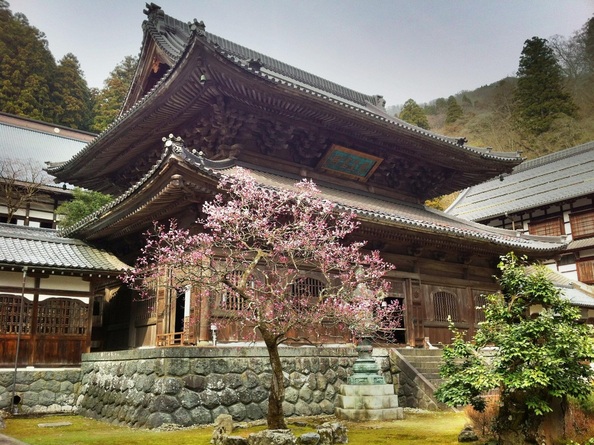 Butsuden at Eiheiji Eiheiji is perhaps the most important place of pilgrimage for Soto Zen practitioners. It is here that founder Dogen established his training monastery in 1244 and where his first writing, the Fukanzazengi (Universally Recommended Instructions for Zazen) is stored. Today it is a full training monastery with over 200 monks in residence.
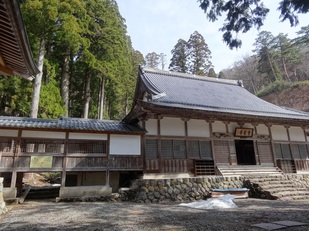 But we didn’t go straight to Eiheiji – instead Toha Osho took us on a historical tour of Zen Buddhism in the region, taking us first to the remote Hokyo-ji Temple, which was founded by Dogen’s friend and student, Jackeun after Dogen’s death. It is unique because it is one of few Zen temples founded by a foreigner and was founded after a schism at Eheiji over leadership caused Jackeun to leave. Jackeun’s students would continue to lead Eiheiji until 1468 when the lineage of Keizan (who founded Soji-ji temple) assumed leadership.
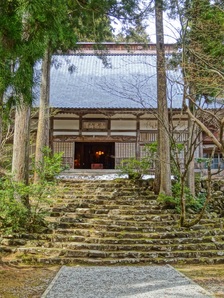 Next we visited Kippo-ji, a temple where Dogen lived over a cold winter in 1243, writing many parts of the Shobogenzo during that time. It is important in Zen practice because it was during this time that Dogen started to elevate monastic practice over lay practice. It is thought this may have been because the winter had caused the monks’ morale to be very low and that Dogen was attempting to inspire them while Eiheiji was being built. Interesting how even great Zen Masters have to make compromises to keep popular support, huh? One of the most memorable parts of the visit to the monastery was a flat rock in the back of the grounds were it is said that Dogen meditated.
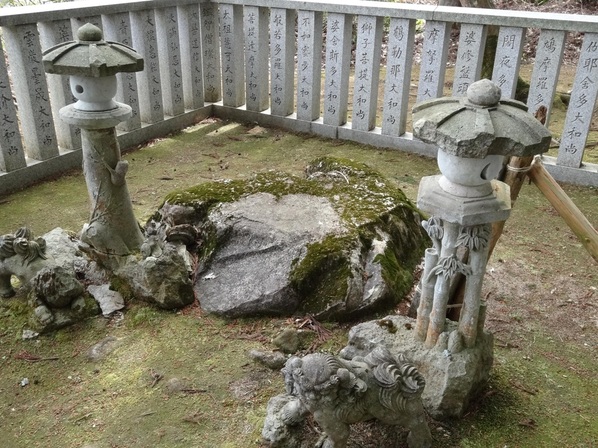 Dogen's meditation rock at Kippo-ji. The writing on the pillars behind lists the lineage of teachers reaching from Buddha to Dogen 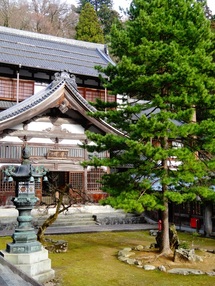 Finally, we made it to Eiheiji, a temple completed only 10 years before Dogen’s death. It was his realization of a dream to have an ideal training monastery nestled in the mountains and rivers of nature. Rev. Kuroyanagi, head of international students, had come from his home temple in Nagano to lead a group of Karate practitioners on a tour of the temple and to receive and introduction to zazen. We knew the zazen part, but we still appreciated seeing the Joyoden (founders hall), where Dogen’s remains are interred and to practice the morning service in the Hatto (Dharma Hall). It was quite an experience to walk down the isle to offer incense while surrounded by the reverberating chants of 200 Zen monks. They even offered my name during the chants for well-being (my name had been on the register of guests). While doing all of this, Toha-Osho cheerfully tagged along and pointed out tiny aspects we might have missed (he practiced at Eiheiji when he was younger). We felt such tremendous gratitude to this man who had sacrificed his time just to show a couple of foreigners around this special temple!
One further note on Eiheiji – it was the first time we had seen a Japanese Soto Zen monastery functioning fully with monks and it made us truly appreciate the training we had received at the Austin Zen Center under our teacher Seirin Barbara Kohn. We understood all the forms they were using at the temple and in many ways it felt a bit like home. Barbara did a great job of creating a little microcosm of a Zen monastery right there in the heart of Austin! Strangely, American Zen Centers now seem to retain the forms and practices of Eiheiji and Soto Zen to much greater extent that temples in Japan, which have largely become places for ceremonial practices rather than zazen and zen training. 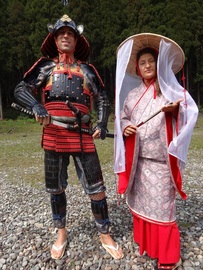 When the morning came (bright and early at 3:30am!) and zazen, services, and breakfast were over, we left Eiheiji and thought we would head to the station to say our goodbyes. But Toha-Osho had one more surprise in store for us. As we all nodded off to sleep (we only slept 3 hours or so the previous night) he took us to the Ichijodani Asakura Clan ruins, where they have reconstructed the town built up around the Asakura Family Mansion, which was burned down by Oda Nobunaga in 1568. There Toha-Osho and Rika cajoled us to don a samurai costume for Jeff and a kimono for Neda, making for some of the most hilarious pics on the trip so far! See all the pics of our pilgrimage to Eiheiji here!
Our time with Toha-Osho, Rika, and her family, was inspiring beyond words. It showed us the power of love and generosity to shine through even when there is almost no connection through language. It was a metaphor for all of Zen practice for us – to find compassion and wisdom beyond words and letters and to thereby live more authentic lives. There is no greater gift. Domo arigato gozaimasshta!
The cherry blossom tree, or sakura, holds special significance in Japanese culture. They bloom for only a week or two in the springtime and the lack of any green parts of the plant results in the delicate snow-white blooms transforming ordinary streets into magical pathways of ephemeral beauty. Indeed, the cherry blossoms have a distinctly Buddhist symbolism in that they produce stunning beauty for a short time before their flowers float down to the earth. As the famous Haiku poet penned: simply trust!
cherry blossoms flitting
down
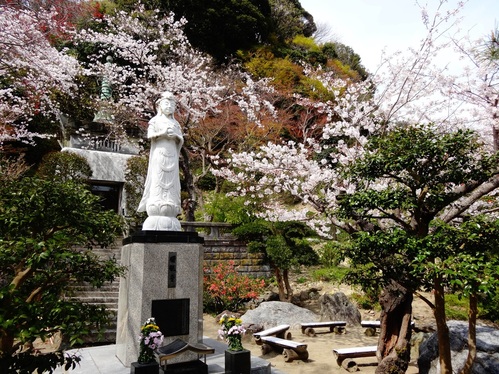 Kannon (Avalokitesvara) at Kencho-ji Temple, Kamakura Issa points out the essence of the cherry blossom teaching. It is not just the fact of our transient nature, our limited time on this earth. It is the movement of surrender to that nature and the contentment that comes from trusting in it. To appreciate time’s inexorable hold over us and our ability to transcend it by embracing it.
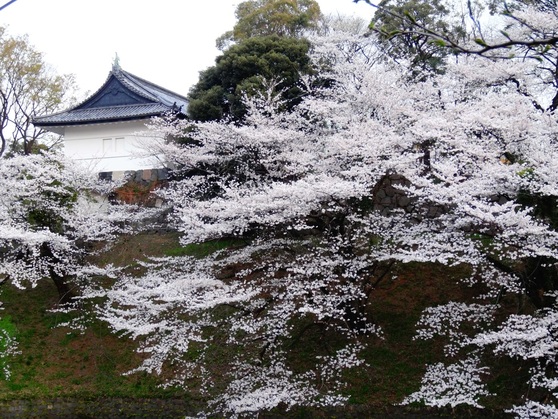 Cherry Blossoms lining the moat of the imperial palace 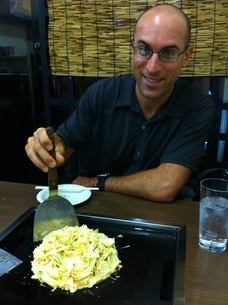 Could we have been any luckier? We arrived in Tokyo to find the cherry blossoms (sakura) in full bloom – nearly two weeks earlier than expected! We arrived at our hotel late in the evening and as we walked to reach it, we saw our first cherry blossom tree – leaves twinkling in the light like the season’s first snow. That night we got our first taste of real Japanese cuisine (the kind you don’t find in America) when we stumbled into a little restaurant and asked in broken Japanese what they recommended. The hostess/proprietor came out with a bowl full of cabbage, shrimp, squid, cheese, egg, and flour mixed with water. We were supposed to cook it ourselves on the teppan (grill) in front of us, but when she realized our ignorance she helped us along, plopped it all down and expertly cooked it so that within minutes we had delicious Okonomiyaki! I think of it as a Japanese omelet, but they called it Japanese pizza.
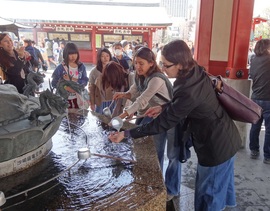 Ritual washing Ritual washing Our first day in Tokyo we walked down to the Asakusa area, home of the famous Senso-ji temple. Senso-ji is a Tendai Buddhist Temple and is the oldest temple in all of Tokyo. Feeling serendipitous in our timing yet again, we were able to meet up at Senso-ji with Neda’s cousin Iliyana, who was leading her family on a tour of Tokyo that week. What a coincidence to be able to meet up with Bulgarian family half way across the world! Illiyana and her old classmate Heidi showed us how to ritually wash our hands and mouth and also how to cleanse ourselves with incense smoke before making an offering to the statue of Kannon (their version of Avalokitesvara, bodhisattva of compassion). A little mystical for us pragmatic Zen practitioners, but an enjoyable culture experience nevertheless. The temple also featured a beautiful stroll garden called Denbo-in, which bursting with cherry blossoms, made for a contemplative walk.
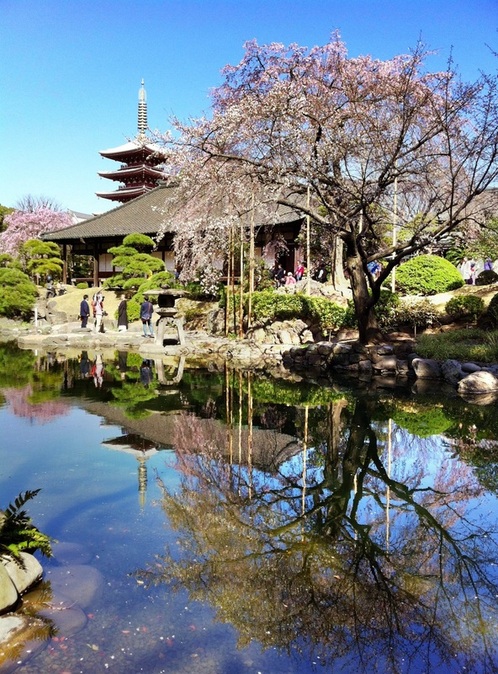 Denbo-in stroll garden with views of the 5 storied pagoda of Senso-ji From Senso-ji we cruised down the Sumida River, enjoying a view of Tokyo by the waterway which used to be the predominant transportation veins of the city. We capped off a busy day back at our hotel, which was hosting a cheerful sushi making party! The staff patiently showed us how to make sushi rolls and also fed us delicious sashimi and nigiri. The next day, it was time to head off to the most famous cherry blossom viewing area in Tokyo – the expansive Ueno Park. Our hotel was located between Ueno and Asakusa, so we were able to walk to Ueno as well that day. It was a Saturday morning and the massive park was as crowded as a subway train during rush hour. Yet everyone’s head was craned slightly upward and there was a quietly reverent tone to the whole affair as the cherry blossoms painted white brushstrokes against the overcast sky. It was truly absorbing – as the famous Zen poet Basho wrote: Clouds of cherry blossoms!
Is that temple bell in Ueno
or Asakusa?
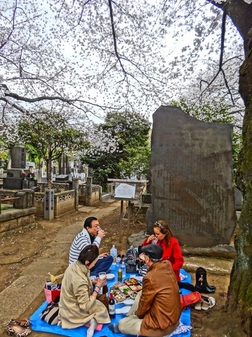 The only break in the quiet came from the picnickers who had set up tarps under the trees and were busy eating, drinking, and laughing. These impromptu gatherings are called Hanami, which roughly translates as “cherry-blossom viewing parties”. It is seen as a celebration of our cherry blossom nature to gather under the trees with friends and loved ones and celebrate life and beauty even as they are passing away above us. The spiritual intonations of Hanami were even stronger as we walked north to Yanaka cemetery, where the graves of the city’s famous citizens were lit from above by the blossoms. Even alongside the graves Tokyoers had set up their tarps and were toasting life while sitting next to reminders of death. Truly a Buddhist party!
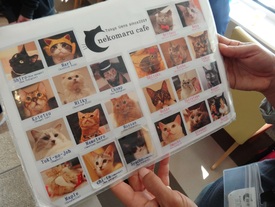 After all that walking we needed to relax and thought it was the perfect time to seek out a uniquely Japanese relaxation technique we had heard about on NPR several years before. We rode the elevator to the 8th floor of a building near Ueno station and the doors opened to a truly quixotic scene. A cat café! Walking into brightly a lit room full of cat toys and furniture, we were given a “menu” to peruse the names of the different cats that were available for viewing, playing, and cuddling. Some Japanese people sat sipping coffee and gazing at the cats, others snapped photos or played with them. Having experienced a bit of kitty deprivation recently as we’ve been too long away from our little Brandy cat, we jumped right in and played around with the cuties. But not for too long, the cat café charges about $4 per person every 15 minutes so the prices can add up. Only in Japan, where apartments are often too small to have an animal and the people have an inordinate love of cats, could this business survive!
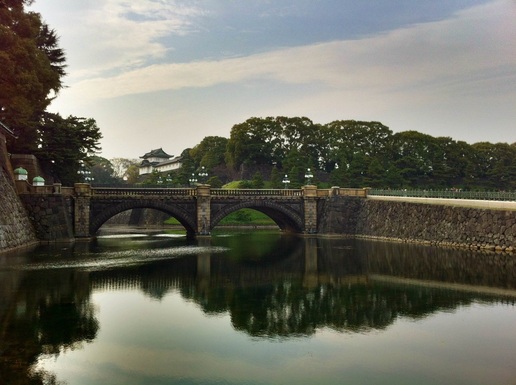 Imperial Palace 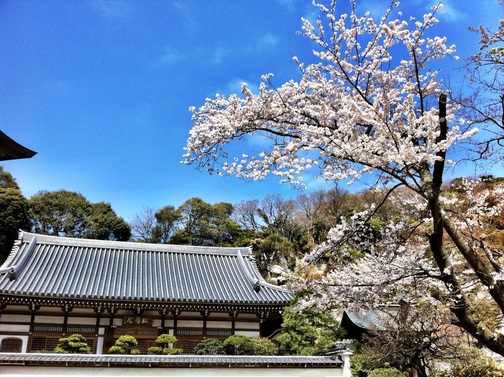 Engaku-ji Temple, Kamakura 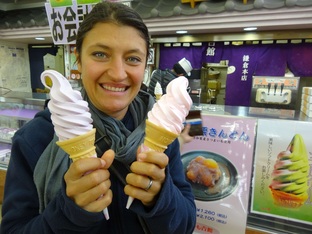 Sweet Potato & Cherry Blossom Ice Cream! Sweet Potato & Cherry Blossom Ice Cream! Our last day we took a day trip out to Kamakura, which was Japan’s first Shogunate Capital from 1185 until 1333. Founded by famous samurai Minamoto no Yoritomo, Kamakura became a bastion for Rinzai Zen and contains many beautiful temples. We visited the largest of those temples, Engaku-ji and also the oldest training monastery in Japan, Kencho-ji. Then we walked along the streets of Kamakura City and tried their famous sweet potato soft serve! The Japanese have wonderfully different flavored soft serve here with some of our favorite flavors so far being green tea matcha, black sesame, and the seasonal cherry blossom flavor!
No visit to Kamakura is complete without viewing the ancient Daibutsu (Great Buddha) cast in 1264 that uses distorted proportions to make it appear balanced (a use of perspective that may show Greek influence via the Silk Road). The 44 foot tall Buddha sat gazing at a beautiful cherry blossom in bloom, bring another Issu haiku to mind: the Buddha too
looks this way...
cherry blossoms!
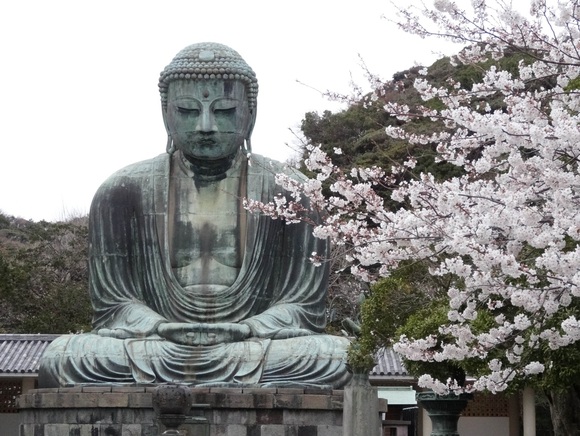 Daibutsu (Great Buddha) Statue - Kamakura Japan marks the beginning of the end of our grand adventure. We have tickets booked to Seoul and then Istanbul before we return to Bulgaria for the summer. Our time in Tokyo was a perfect reminder to enjoy each moment of the trip because the days will fall like blossoms caught in the wind…
The wind has settled, the blossoms have fallen;
Birds sing, the mountains grow dark --
This is the wondrous power of Buddhism.
|
















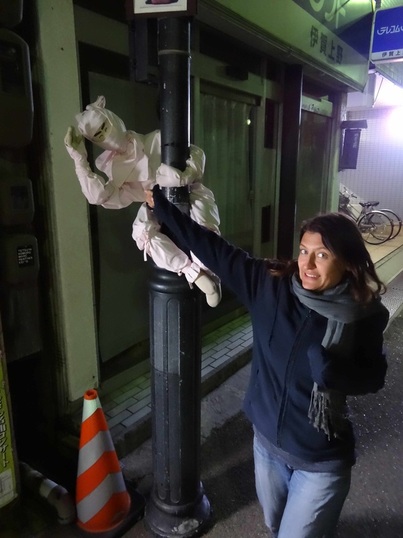


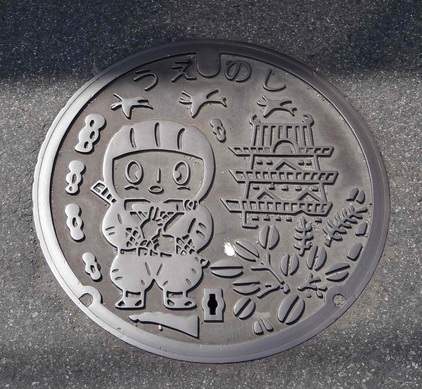

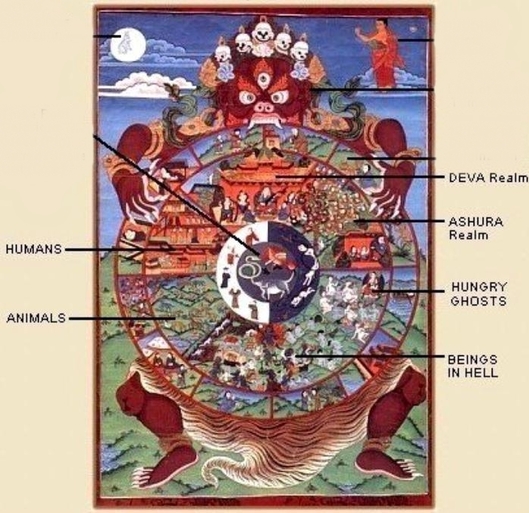

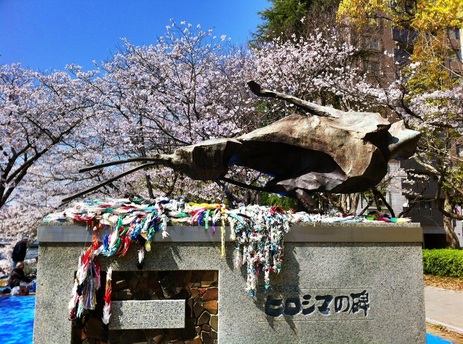
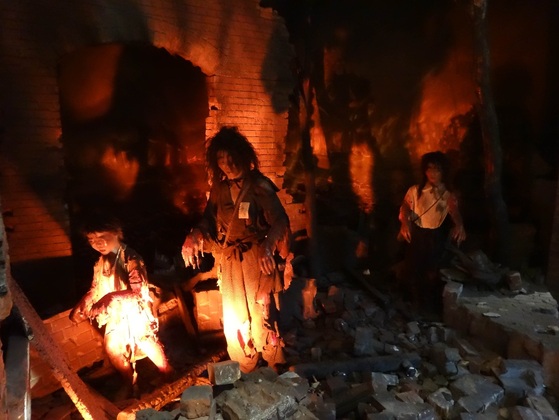



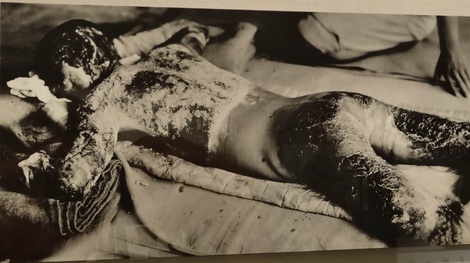







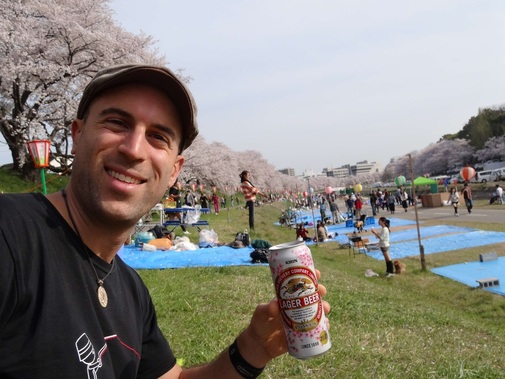

















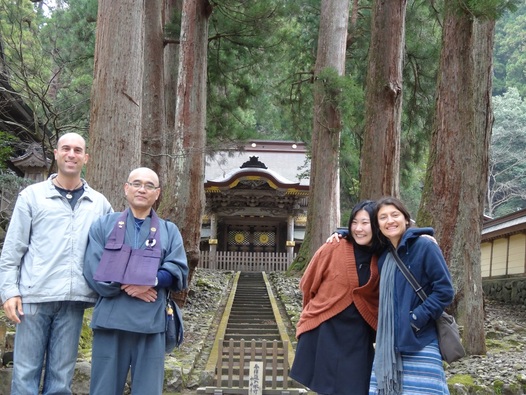

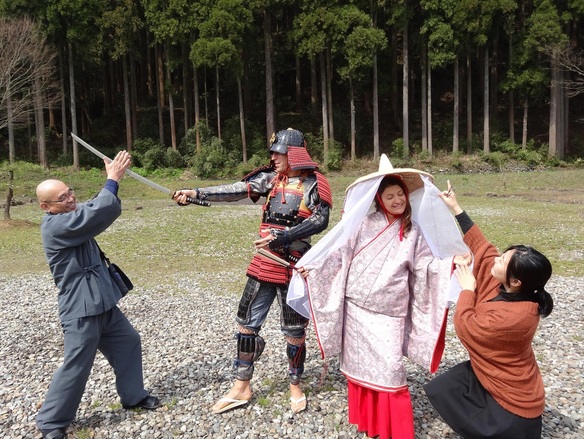
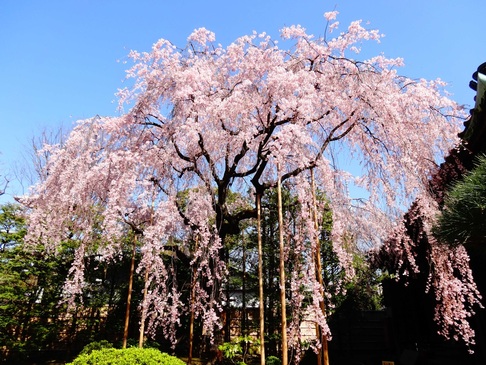





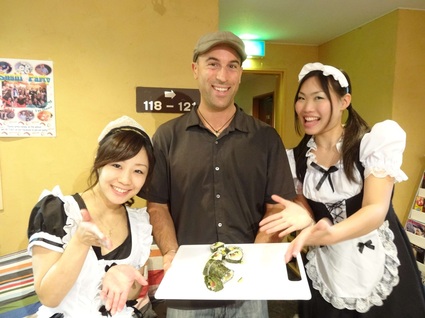
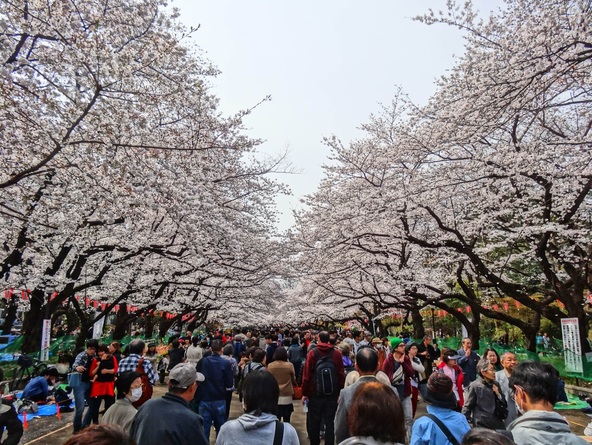


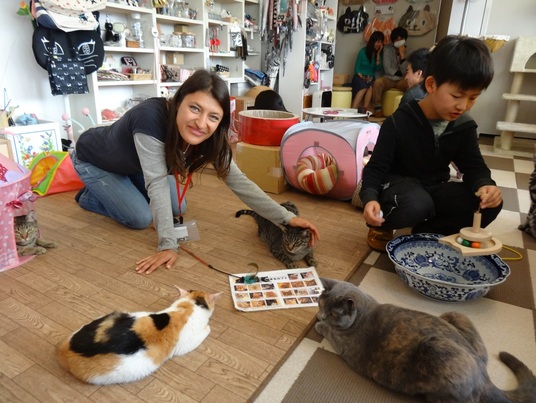




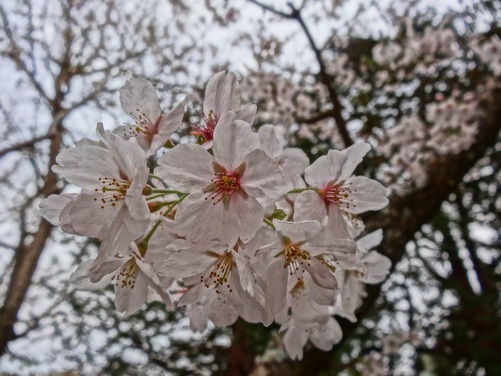
 RSS Feed
RSS Feed